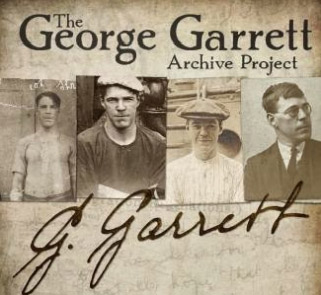
| HOME |
| NERVE |
| REVIEWS |
| ARCHIVE |
| EVENTS |
| LINKS |
| ABOUT US |
| CONTRIBUTORS |
| BACK ISSUES |
| CONTACT US |
George Garrett Archive
 Liverpool
Central Library, William Brown Street
Liverpool
Central Library, William Brown Street
3rd - 31st May 2014
By Adam Ford
Going to the newly refurbished Liverpool Central Library is a weird experience. With its shiny up-to-the-minute feel, it serves as a hint of what public services could be like, if only a decent amount of resources were dedicated to them. On the other hand, it also doubles as an excuse for Liverpool council to point to as they devastate public services - including public libraries - and the lives of the people who rely on them.
As the Labour councillors do the Tories' dirty work for them, it is even stranger to see the council's logo attached to a display celebrating the work of one George Garrett, a man who stood for everything that these intensely mediocre butchers, bloodsuckers and bootlickers despise. Doubtless Mayor Anderson has nightmares about working class people standing up for themselves at work and in politics, and producing their own culture, reflecting their own lives.
It is of course an extremely difficult task to represent a life as large and full as Garrett's in a few smallish glass show cases (I won't even try in this article). Born in Seacombe in 1896, his family moved to Dingle at the turn of the century, and he went on to become a docker, a sailor, a union organiser, a poet, a songwriter, a playwright, and an actor, plus a father to five sons. As well as Merseyside, he lived in New York and Argentina at various times.
Amidst all the scripts, magazines and rejection letters, it can't be said that the display gives much of a flavour of Garrett's political and labour organising. For instance, his Byrom Street address is listed as home of "the Wobblies" as well as the Liverpool branch of the Communist Party in the early 1920s. For all that most library visitors are likely to know, the Wobblies might be a jelly manufacturer (in fact it is a nickname of the Industrial Workers of the World union), but no explanation is provided.
This is no small point. It isn't as if Garrett's political work and his cultural output were two separate worlds to him; everything he did was searingly political. He composed songs for sailors which were clearly influenced by the work of another wobbly: Joe Hill. His writing took the lives and struggles of working class people as their starting point. In later life, he helped set up the Left Theatre (now the Unity Theatre), to help bring the conflict between the Spanish revolution and the fascism of Franco to life for the people of Liverpool. In short, Garrett's art can only be understood in the context of his politics.
Despite all that, this exhibition (and accompanying website) are a tantalising glimpse of a fascinating man, and I hope that the archive is a work in progress which can be improved upon. The project is clearly a labour of love for the volunteers, and they deserve a lot of credit for putting this material in the public domain.
Sorry Comments Closed
Comment left by johno on 24th May, 2014 at 14:20
Good exhibition should be seen by all slice of raw Liverpool history.ps play wed 28th may unity 7pm